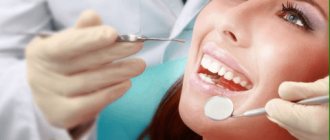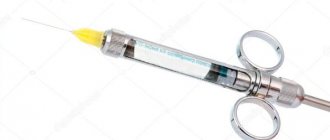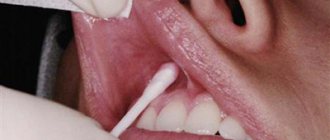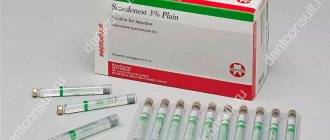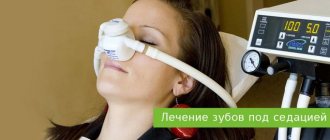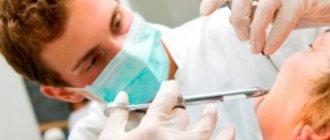When is antibiotic treatment necessary in dentistry?
Most often, antibiotic therapy is prescribed in maxillofacial surgery - as a prophylaxis before surgery and to minimize the risk of complications after it. In dental clinics in Moscow it is indicated for patients:
- with catarrhal gingivitis;
- with periodontitis, in which there is a need for treatment of a dental cyst;
- with advanced periodontitis and periodontal disease;
- with periostitis and osteomyelitis;
- after a complex tooth extraction.
Since the bacterial microflora of the oral cavity is mixed, antibiotics with a wide spectrum of action are prescribed to treat inflammation.
What are the dangers of taking medications on your own?
The need for antibiotic therapy is determined by the nature of the disease and the body’s response to it. Selectivity in its appointment is explained by two reasons.
- Antibiotics affect all types of microflora, both harmful and beneficial, which in some cases can lead to problems with the mucous membranes of other organs and exacerbation of chronic diseases.
- When exposed to them, bacteria begin to mutate, forming resistance to drugs of a certain type. For this reason, first-generation drugs, such as penicillin, have already ceased to act on pathogens. Scientists have proposed new developments, but if used thoughtlessly, without following the rules of therapy, history may repeat itself.
In addition, each of the drugs has its own side effects - from nausea and itching to anaphylactic shock. Their manifestations may require immediate medical attention.
Therefore, dentists prescribe a course of antibiotics only in cases where the likelihood of complications of the disease exceeds the risks of taking the drug. At the same time, they consciously approach the choice of medication and its dosage, as well as the duration of the course. Let's look at what can lead to self-prescription of an antibiotic for tooth root inflammation.
antiseptics in dentistry
| Definition Antiseptics and disinfectants refer to antimicrobial agents that lack selectivity of antimicrobial action (they are active against most microorganisms, protozoa and fungi and do not cause the development of resistance). Antiseptics are used to destroy pathogens located on the surface of human tissue. They are applied to the skin and mucous membranes (including the gastrointestinal tract and urinary tract); in dentistry they are used to treat pathological periodontal pockets with periodontal disease, root canals and tooth cavities. The mechanism of action of most antiseptics is associated with their ability to denature proteins (structural and enzymatic) and thus have a bactericidal effect. Due to the lack of selectivity, antiseptics are organotropic in relation to the macroorganism). Classification and main representatives Antiseptics and disinfectants are classified according to their chemical structure: I. Halogen-containing compounds (derivatives of chlorine, iodine, etc.). Antiseptics of this group have a pronounced bactericidal, sporicidal, fungicidal and deodorizing effect. The most active drugs are those containing elemental halogens or releasing them (bleach solution, chloramine B, alcoholic iodine solution, Lugol's solution, iodinol, iodocam, iodoform, pantocid). II. Oxidizing agents (potassium permanganate, hydrogen peroxide solution, hydroperite). The principle of action of drugs in this group is the release of oxygen and oxidation of organic components of the protoplasm of microorganisms. They have a deodorizing effect. A solution of hydrogen peroxide helps to mechanically cleanse the wound and stop bleeding. III. Antiseptics of the phenol group (pure phenol, resorcinol, tricresol, ferozol, resorcinol, benzonaphthol, vagotil). Phenol has bactericidal, sporicidal and fungicidal effects. Irritates tissue, is easily absorbed from the site of application, toxic. It is used as an antiseptic in dentistry during root canal treatment and necrotization of the dental pulp. Vagotil has a local bactericidal and trichomonacid effect. Resorcinol is inferior to phenol as an antiseptic. In small concentrations it has a keratoplastic effect, and in large concentrations it has a keratolytic and cauterizing effect. The phenol group also includes eugenol (allylguaiacol), which is the main component of clove oil and has a disinfectant and local anesthetic effect. IV. Aliphatic antiseptics from the group of alcohols and aldehydes (formaldehyde solution, hexamethylenetetramine (methenamine), ethyl alcohol, beta-1-lysoform, cyminal). Formaldehyde preparations have antimicrobial, sporicidal, deodorizing, dehydrating and mummifying properties. They are used to treat skin during sweating, and in dentistry for necrotization and mummification of dental pulp. The antimicrobial activity of ethyl alcohol increases with increasing its concentration. It does not affect disputes. |
| Disinfectants for medical, children's and veterinary institutions.septustin.ru |
In dentistry, this group of drugs is used very widely. Antiseptics are used to treat the surface or cavities of the human body, disinfectants are used to treat external objects, instruments, impressions, dentures and their semi-finished products or patient secretions. The spectrum of action of antiseptics and disinfectants is wide and extends to bacteria, fungi, protozoa and some viruses. The mechanism of action may be associated with protein denaturation, disruption of the permeability of the plasma membrane, and inhibition of the activity of microbial enzymes. Halogen-containing antiseptics include iodine and chlorine preparations. In dentistry, iodine preparations (an alcohol solution of iodine with the addition of tannin and glycerin, potassium iodide, iodinol, iodoform, etc.) are used to treat the mucous membrane, treat and diagnose gum diseases, arthrosis of the temporomandibular joint, etc. Preparations containing iodine can cause irritation mucous membrane and allergization upon repeated use. The irritating effect is minimized with iodine preparations on an organic carrier (iodinol, povidone iodine). A highly effective antiseptic and disinfectant is a dichlorine-containing biguanide derivative - chlorhexidine, which has bicationic properties, does not have a damaging effect on tissues and is used in dentistry both as an independent drug (solution) and in the form of various combined dosage forms (rinses, toothpastes for therapeutic and prophylactic purposes , tablets for resorption in the oral cavity, etc.) for the treatment of ulcerative stomatitis, gingivitis, and the prevention of caries. From the group of oxidizing agents, hydrogen peroxide and potassium permanganate are used, which have an antiseptic, deodorizing and hemostatic effect due to the release of oxygen. From the group of aldehydes, formaldehyde (preparation of a resorcinol-formalin mixture for filling root canals, a disinfectant) and paraform (pastes for pulp devitalization) are used in dental practice. Formaldehyde has bactericidal, virucidal, funcidal and sporicidal effects. The acids are represented by boric acid and sodium tetraborate, which have a pronounced antimicrobial and antifungal effect (treatment of stomatitis, especially candidiasis). Among metal salts, silver nitrate is widely used (impregnation of difficult-to-pass channels). An extensive group of drugs in dentistry consists of phenols, which have diverse effects, including: local anesthetic, cauterizing and necrotizing (phenol or carbolic acid, vagotil), keratolytic and keratoplastic (resorcinol), astringent and deodorizing (thymol, biclotymol) effects. Phenol has the greatest potential toxicity in this series.
Dyes are represented by brilliant green, methylene blue and ethacridine lactate (treatment of skin and oral mucosa). Detergents (dimexide, miramistin) are used to treat periodontal diseases and oral mucosa, to prevent suppuration and purulent wounds. Ethyl and isoprylic alcohols (at a concentration of 60-90% by volume), which are used for disinfection, have bactericidal and virucidal properties.
| BETADINE Antiseptic drug. Solution for local and external use |
| HEXICON Antiseptic drug for external and local use. Gel for local and external use. Solution for external use |
| HEXORAL Antiseptic drug for topical use in ENT practice and dentistry. Aerosol for topical use 0.2%. Solution for topical use 0.1% |
| YOX A drug with antimicrobial and anti-inflammatory effects for local use in ENT practice. Solution for topical use. Topical spray |
| METROGYL DENTA For the treatment and prevention of infectious and inflammatory diseases of the oral cavity. Dental gel |
| SEPTOLETE NEO Antiseptic for topical use in ENT practice and dentistry. Pastilles |
| ELIGEL Antiseptic for local use in dentistry. Gel for gums |
When carrying out preventive measures, it is necessary to use antimicrobial drugs that affect both anaerobic and aerobic microflora. One of the most universally effective antiseptics is a biguanide derivative - chlorhexidine.
It is part of many therapeutic and prophylactic products, including toothpastes. Chlorhexidine causes a pronounced effect on gram-positive and gram-negative bacteria, fungi, facultative aerobes and anaerobes, herpes viruses, reducing the number of microorganisms in saliva that stimulate the formation of dental plaque by 80-90%.
The effect of chlorhexidine in relation to microorganisms is explained by the interaction between the positively charged molecule of the drug and negatively charged groups of molecules in the bacterial cell wall, which facilitates the penetration of the active component into the cytoplasm of the microorganism and its destruction.
Chlorhexidine is selectively adsorbed on the surface of hydroxyapatite tooth enamel, thereby preventing the adsorption of bacteria. In addition, binding to the protein structures of oral tissues causes a prolonged effect due to its gradual release. In addition to being bactericidal, chlorhexidine has a weak analgesic property. Long-term use of pastes with 2.2-0.4% chlorhexidine can lead to increased formation of tartar and oral dysbacteriosis.
These side effects are reduced in some formulations by the addition of chelating agents.
Recently, triclosan, a phenol with a broad antimicrobial effect, has been widely used. Effective against yeast fungi, gram-positive and gram-negative microorganisms, has a bacteriostatic or bactericidal effect due to the effect on the cytoplasmic membranes of bacteria, depending on the concentration. Compatible with other components of hygiene products, does not cause the formation of resistant microbial strains. As already indicated, along with the positive effect, the listed drugs can also have side effects on the tissues of the oral cavity, therefore their use as prophylactic agents should be monitored by specialists.
Antiseptic agents (most often chlorine-, phenol- or triclosan-containing) are included in such therapeutic and prophylactic pastes as Lacalut, Colgate, President, Aquafresh. Histerine, etc. In addition, these components, in various versions and in combination with herbal additives and fragrances, are also included in rinses.
"Elgidium" is an antibacterial toothpaste containing chlorhexidine digluconate and calcium carbonate. The effect of chlorhexidine is described above. Calcium helps reduce gum bleeding, neutralizes oral fluid when it becomes acidic and enhances the effect of chlorhexidine. The therapeutic effect of one cleansing with Elgidium lasts 24 hours, which is a clear advantage of this product.
One of the predisposing factors for the occurrence of an inflammatory reaction in the periodontium, with the same strength of the damaging effect of microflora, is a decrease in the effectiveness of antioxidant protection of tissues under the influence of various pathogenic influences of a general nature: stress, somatic diseases. Therefore, the use of correction of the relationship between the pro-oxidant and antioxidant systems of periodontal structures with the help of antioxidants is a pathogenetically justified effect.
From this point of view, Mexidol toothpaste (TK Pharmasoft LLC) deserves attention, containing the drug Mexidol, as well as a 5% Mexidol solution for rinsing. Of unconditional interest are the President line preparations, both pastes and rinses, the preventive effect of which is also due to their antioxidant effect due to plant extracts and, of course, the specific effect of triclosan.
President Active is a paste with controlled abrasiveness RDA 75. It contains: zinc citrate 0.75%; triclosan 0.35%; extracts of sanguinaria, hawthorn; sodium fluoride 0.32%. President Exclusive paste, which contains hexitidine 0.1%; thyme extract, propolis; monofluorophosphate 0.8%, sodium fluoride 0.1%. The mechanism of preventive action of Colgate pastes is similar: Colgate Propolis, containing propolis; "Colgate Medicinal Herbs", which includes a number of plant extracts: eucalyptus, tea tree, sage, myrrh and chamomile.
Source: https://meduniver.com/Medical/stomatologia/649.html MedUniver
Your login:
58cd01520f4b
Your password:
0e2bd534495b
